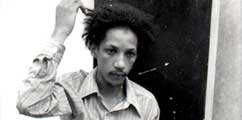Strip reggae – any sort of
reggae – back to its essence and you’ll be back to the bass
and drum, the groundation of everything that happens in the
music. But if you then rebuild on that bass and drum with the
imagination, the invention and the sheer mixing board
dexterity of King Tubby, Lee Perry or Scientist, you’ll be
dubbing.
The art of dub is more than merely remixing,
although remix culture is an extension of the dubmasters
craft, it’s redefining a tune by taking its essential elements
and rebalancing them in a way that gives the finished article
a whole different meaning but still exists within the same
parameters. Witness the Augustus Pablo/King Tubby classic
"King Tubby’s Meets Rockers Uptown", an edgy, altogether
dangerous three minutes that was once the cool lovers rock of
Jacob Miller’s "Baby I love You So".
Dub began in
Kingston in the late 1960s, when deejays were looking for gaps
in records’ vocal performances to toast both their sound
system and their selves. "Version" was the name given to these
instrumental sides, but, thanks to the 1970s’ rapidly
developing studio technology, where was the challenge in
simply dropping the vocals in and out?
Filters, faders
and multi-track recording allowed any component part of the
tune to be pushed backwards and forwards in the mix, while the
echo chamber and reverb unit brought a whole new dimension to
what they’d sound like when they got there. Suddenly, the
mixing desk was the most important instrument in the studio
and the man who could operate it was the biggest star. King
Tubby’s, Scientist, King Jammy’s, Joe Gibbs & Errol T, Lee
Perry, Mikey Dread, Gussie Clarke … it was this generation of
Jamaican dubmasters that paved the way the way for today’s
superstar remixers such as Fatboy Slim, Armand Van Helden and
Masters At Work. Dub also had a major influence on the likes
of Massive Attack, Mouse On Mars and a whole generation of
sonic terrorists.
.
|

